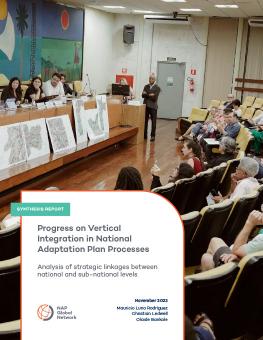
Progress on Vertical Integration in National Adaptation Plan Processes
Analysis of strategic linkages between national and sub-national levels
Vertical integration for climate change adaptation is the process of creating intentional and strategic linkages between national and sub-national governance levels in the planning, implementation, and monitoring, evaluation, and learning stages. This synthesis report presents an analysis of how countries are advancing vertical integration in national adaptation plan processes.
-
Most developing countries' NAPs define a role for sub-national governments in climate change adaptation—most often planning and implementation, and, to a lesser extent, MEL.
-
All NAPs reference at least one non-state sub-national actor-CSOs, small businesses, communities, smallholder producers, and groups representing women, Indigenous Peoples, youth, and persons with disabilities.
-
Many NAPs refer to community-based adaptation and locally led adaptation, recognizing the importance of local context for adaptation action.
Vertical integration for climate change adaptation is the process of creating intentional and strategic linkages between national and sub-national governance levels in the planning, implementation, and monitoring, evaluation, and learning (MEL) stages. Sub-national-level governments and local actors are already taking action to adapt to the climate change impacts being felt by communities. Local-level adaptation needs to be carefully linked to and supported by national-level adaptation planning to channel resources to the people, places, and systems that need them most.
The national adaptation plan (NAP) process presents a critically important opportunity to scale up effective, inclusive adaptation. By building strategic and intentional links with sub-national adaptation planning and implementation through vertical integration, the NAP process can support climate change adaptation priorities so that they reflect local realities, channel resources to sub-national actors and actions, and ensure that sub-national adaptation efforts are captured when progress is tracked and reported.
This synthesis report presents an analysis of how countries are advancing vertical integration in NAP processes. The findings are based on data collected through a review of NAP documents submitted to the United Nations Framework Convention on Climate Change's NAP Central as of July 2023. The recommendations are complemented by information gathered during the NAP Global Network Secretariat's engagement with countries' NAP teams.
You might also be interested in
Four Key Elements to Ensure a Successful Global Goal on Adaptation
As the final rounds of negotiations on the GGA kick off at COP 28, a looming question remains: Will it be comprehensive enough for countries to implement in the years ahead?
Public Engagement on Climate Change Adaptation
This report provides an introduction to public engagement on climate change adaptation for decision-makers involved in leading national adaptation plan (NAP) processes.
Learning From Gender-Responsive National Adaptation Plan Processes: Insights from countries to inform the review of the UNFCCC Gender Action Plan
Based on the priority actions of 10 African and Caribbean countries for integrating gender equality in their National Adaptation Plan (NAP) processes, we identified recommendations for effectively advancing the Gender Action Plan (GAP) under the United Nations Framework Convention on Climate Change (UNFCCC).
What Does an Inclusive Global Stocktake Look Like for Civil Society?
The inaugural Global Stocktake will conclude at COP 28 in 2023. With the process well underway, the current and upcoming phases of the Global Stocktake must be open and inclusive in order to succeed.